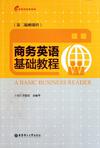商务英语基础教程
出版时间:2012-2 出版社:华东理工大学出版社 作者:李德荣 等主编 页数:270
Tag标签:无
内容概要
李德荣、余丽华主编的《商务英语基础教程(第2版)》共20章,内容涵盖企业和社会、企业所有制形式、管理原理、企业文化、产品、营销、生产管理、人力资源力资源管理、财务管理、电子商务、保险、国际贸易等诸多领域。每章分数个独立的小单元,从不同侧面介绍一个专题领域,务求突出重点,阐明基本概念或基础理论。单元中的疑难单词,可在同行的左或右侧见到释义,以方便阅读。《商务英语基础教程(第2版)》针对文字中的难点,每单元尾部有Notes(注释)加以说明。练习包括讨论题、词汇、阅读和翻译,其内容均与各章主题紧密配合。为便于读者掌握工商词汇和术语,每章辟有Key
Business Terms(重要工商词汇)。书末附有Glossary(专业词汇)和练习答案。
书籍目录
Chapter 1 Business and Society(企业与社会)
I.The Social Respoibility of Business(企业的社会责任)
Ⅱ.Coumerism(保护消费者利益)
Ⅲ.Business Ethics(商业道德)
Chapter 2 Forms ofBusiness Ownehip(1)(企业所有制形式)(1)
I.Sole Proprietohips(个体企业)
Ⅱ.Partnehips(合伙企业)
Chapter 3 Forms ofBusiness Ownehip(2)(企业所有制形式)(2)
I.What Is a Corporation?(什么是责任有限公司?)
Ⅱ.How Corporatio Are Created and Managed?(责任有限公司如何创立和管理?)
Ⅲ.Advantages and Disadvantages of Corporatio(责任有限公司的利弊)
Chapter 4 Management Principles(管理原则)
I.Nature of Management(管理的本义)
Ⅱ.Levels of Management(管理的层次)
Ⅲ.Functio of Management(管理的功能)
Chapter 5 Managerial SkillS and Manage(管理技能和管理人员)
I.Styles of Leadehip(领导风格)
Ⅱ.Managerial Skills(管理技能)
Ⅲ.Where Do Manage Come From?(管理人员从何而来?)
Ⅳ.Better Communication(加强沟通)
Chapter 6 Corporate Culture(企业文化)
I.What Is Corporate Culture?(什么是企业文化?)
Ⅱ.Elements of Corporate Culture(企业文化的组成部分)
Ⅲ.Creating a Corporate Culture(创造企业文化)
Chapter 7 Business Organization and Structure(企业中的组织和结构)
I.Specialization(专门化)
Ⅱ.Delegation of Authority(委派授权)
Ⅲ.Degree of Central ization(集权程度)
Ⅳ.Departmentalization(部门化)
Chapter 8 Products(产品)
I.Nature of Products(产品的本义)
Ⅱ.Research and Development(研究与开发)
Ⅲ.Product Life Cycle(产品的生命周期)
Chapter 9 Pricing(定价)
I.Nature of Pricing(定价的本义)
Ⅱ.Pricing ObjectⅣes(定价目标)
Ⅲ.Pricing Policies(定价政策)
Chapter 10 Production Management(生产管理)
I.Facility Location(厂址选择)
Ⅱ.Product Design(产品设计)
Ⅲ.Quality Control(质量控制)
Chapter 11 Hm Resources Management(1)(人力资源管理)(1)
I.Maslow's Hierarchy of Needs(马斯洛的需求层次理论)
Ⅱ.Herzberg's Two-Factor Theory(赫兹伯格的双因素理论)
Ⅲ.McGregor's Theory X and Theory Y(麦格雷戈的X理论和Y理论)
Ⅳ.Job Enrichment(丁作丰富化)
Chapter 12 Human Resources Management(2)(人力资源管理)(2)
I.The Selection Process(人员选择过程)
Ⅱ.Financial Compeation(经济补偿)
Ⅲ.Promotio,Trafe,and Separatio(提升、调动和离职)
Chapter 13 Marketing(I)(营销)(1)
I.The Marketing Concept(营销的概念)
Ⅱ.Functio of Marketing(营销的职能)
Ⅲ.The Marketing Mix(营销组合)
Ⅳ.Marketing Research(市场调查)
Chapter 14 Marketing(2)(营销)(2)
I.Sales Promotion(促销)
Ⅱ.Advertising(广告)
Ⅲ.Publicity(宣传)
Chapter 15 Financial Management(财务管理)
I.ObjectⅣe of Financial Management(财务管理的目标)
Ⅱ.Sources of Funds(资金来源)
Ⅲ.Uses of Funds(资金使用)
Chapter 16 Accounting and Financial Statements(会计和财务报表)
I.Accounting and Accountants(会计和会计人员)
Ⅱ.The Income Statement(收益表)
Ⅲ.The Balance Sheet(资产负债表)
Chapter 17 Business Law(商业法)
I.TypesandSources of Law(法律的种类和来源)
Ⅱ.The Contract Law(合同法)
Ⅲ.The Law of Property(财产法)
Ⅳ.The Law of Torts(民事侵权行为法)
Chapter 18 Risk Management and Iurance(风险管理和保险)
I.Risk and Risk Management Technique(风险和风险管理技术)
Ⅱ.Basics of Iurance(保险基础知识)
Ⅲ.Types of Iurance and Crisis in the Iurance
Industry(保险的种类和保险业的危机)
Chapter 19 Compute and Information Systems(计算机和信息系统)
I.The Management Information System(管理信息系统)
Ⅱ.The Intemet,Intranets,and Extranets in
Business(企业运用因特网、内联网和外联网)
Ⅲ.Business-to-Coumer E-Commerce(企业对客户的电子商务)
Chapter 20 International Business(国际商务)
I.Theories of Absolute and ComparatⅣe Advantage(绝对利益和比较利益理论)
Ⅱ.Fonlls of International Trade(国际贸易的形式)
Ⅲ.Multinational Business(跨国公司)
Ⅳ.Trade Barrie(贸易壁垒)
Appendix I Glossary(专业词汇)
Appendix Ⅱ Key to Exercises(练习参考答案)
图书封面
图书标签Tags
无
评论、评分、阅读与下载
用户评论 (总计32条)
- 很全面的商务英语教材,纸张很舒服,非常喜欢
- 非常有帮助的一本教程书,课件做得很好
- 书本比较薄,纸质不错,内容充实,每一章都有三四篇文章,知识实用
- 我觉得书很好,内容充实。但是上面写的第二版赠课件,我以为有光盘,可是什么都没有啊。不是太明白这个事。还是觉得很有用,好好学习~
- 还不错的说,利于英语的学习
- 国内的教材,感觉中国味特别浓,不过一些专业知识的分析还是很详细,就是对抽象概念的解释和论证不太严谨和充实。
- 这本书是准备考BEC的,觉得很有用,不过就是说赠的课件怎么没有啊
- 问题是课件在哪里。我第一次接触BEC不知道该怎么学。晕。谁教一下我..
- 很好,也是别人推荐的书,靠它了
- 内容比较全面,但是不够深入
- 更好的家门口的推开门的刚一进门蠹国殃民
- 碰上5折优惠,性价比很高,快递一天就到了,满意
- 没MP3……
- 希望自己顺利通过
- 好呢,打算考高级,觉得还蛮简单的
- 买了有一段时间了,挺好的
- 买来对付商务英语考试 , 可是很多地方都看不懂, 很沉闷, 内容很旧, 还不如看官方教材
- 书涉及面较广,很适合商务英语入门。但书有点偏贵。
- 还没看书,不过质量各方面都不错,可是这本书说赠送课件,请问课件在哪里呢?
- 书本内容是不错,推荐!只是不知道课件怎么样而已。
- 内容不错,但是书怎么感觉像是旧的,而已封面上面有破了个小洞
- 书好,对我有所帮助。
- 书不错,课本用的。
- 这本书对商务中的英语基本应用、企业基本架构有所阐述,内容难度不大,对于商务英语中的合同、订货、文书等未作细致阐述,我还需要再买一本详细一些的商务英语教材
- 话说赠的课件在哪?商家应该告诉我们下课件的途径吧?
- 到货很快,可是书上给的联系课件方式根本没人回信,出版社网址也打不开。
- 请问这本书的课件在哪儿?
- 这本书说有赠送课件,但是我却看不到有,请问课件在哪里呢?
- 不是说赠送课件吗,为什么我没有看到?
- 这次买的书都好丑啊。。。。。。。。全都是皱的,而且好脏啊。。。不满意
- 看过内容还行,可是就跟用过的旧书一样,一点都不新···
- 说好第二版赠课件,在哪啊?
